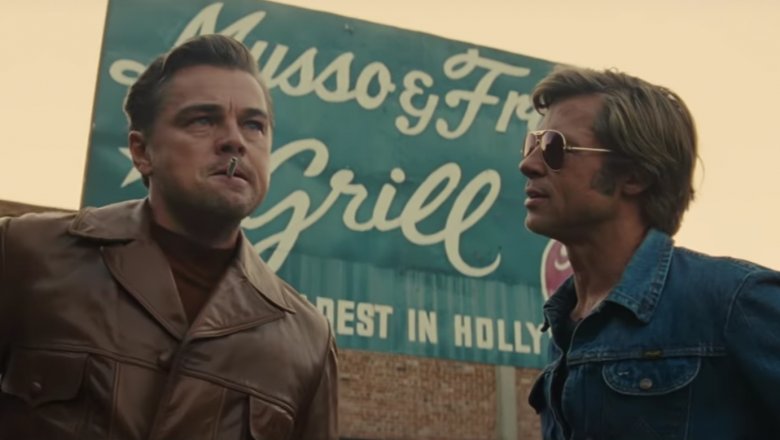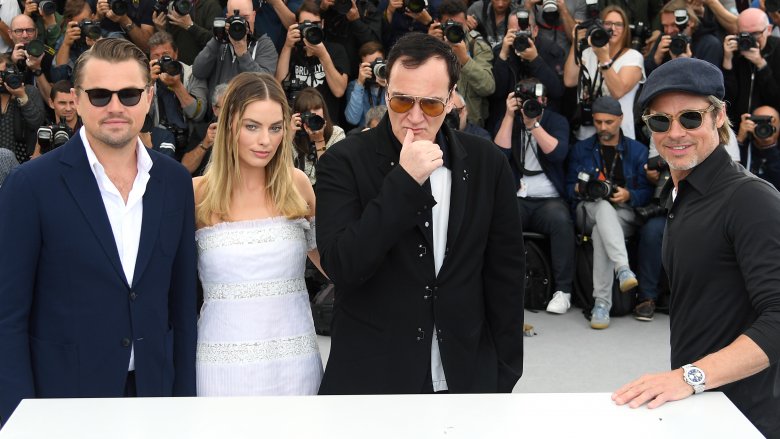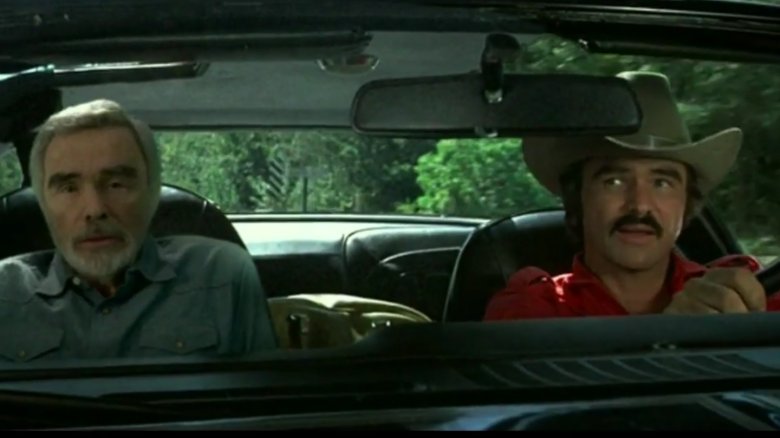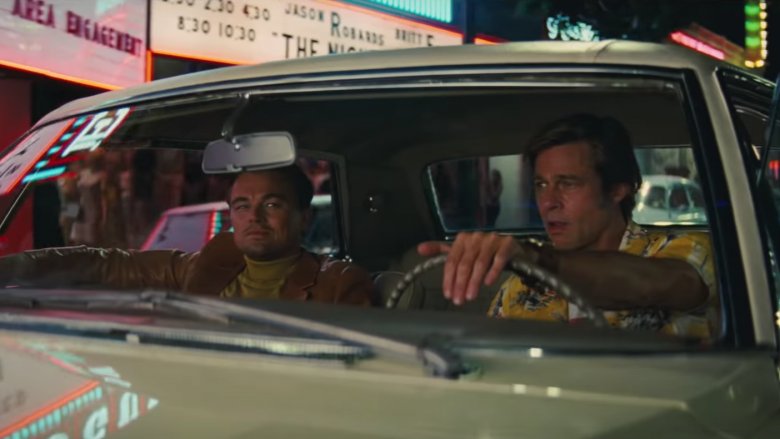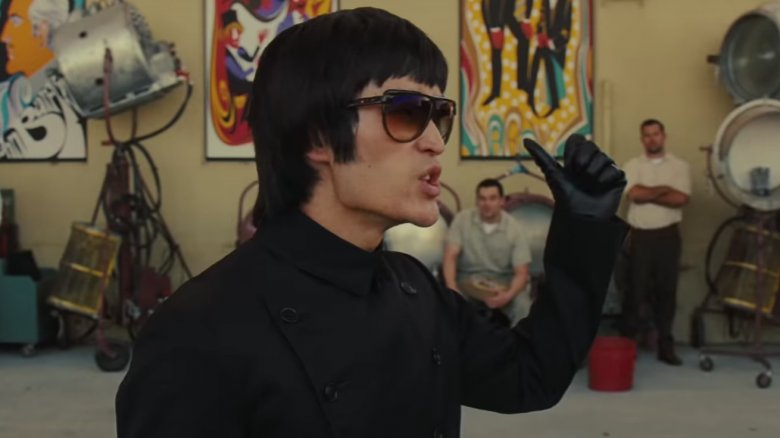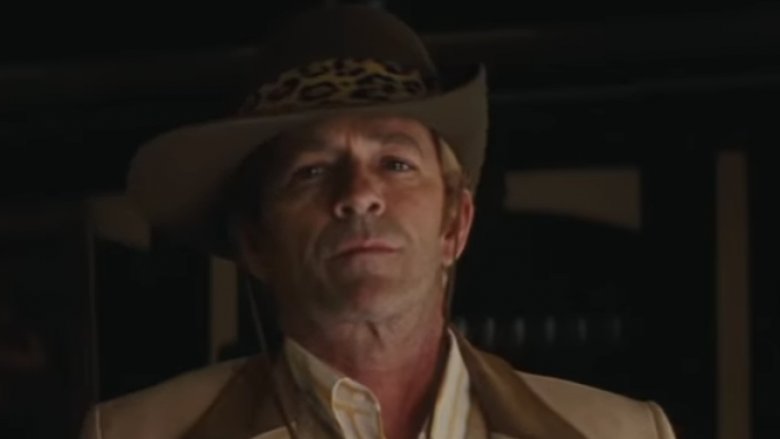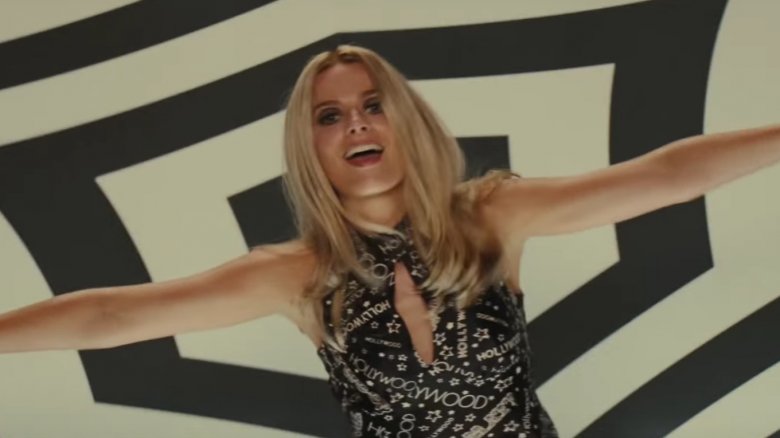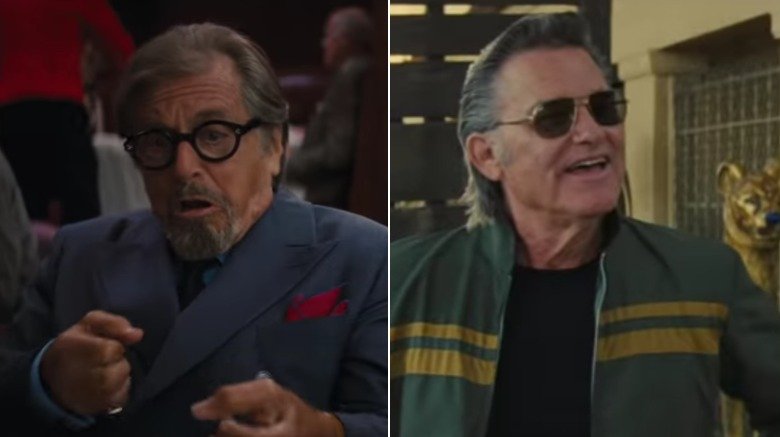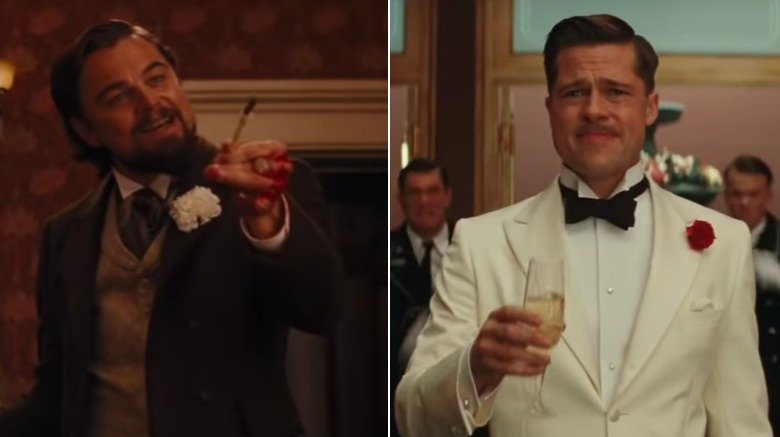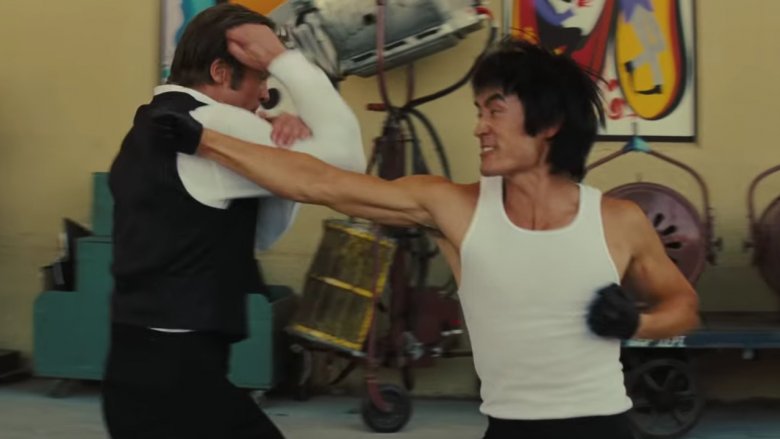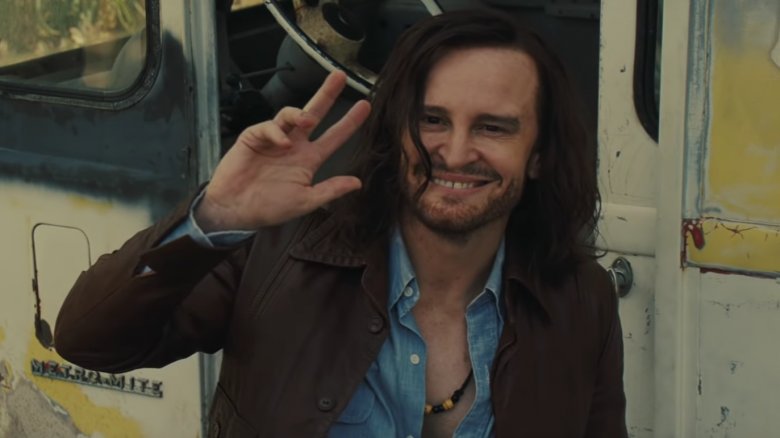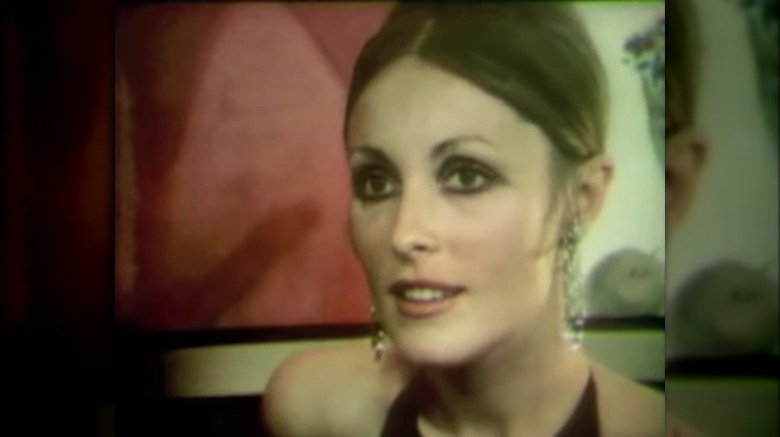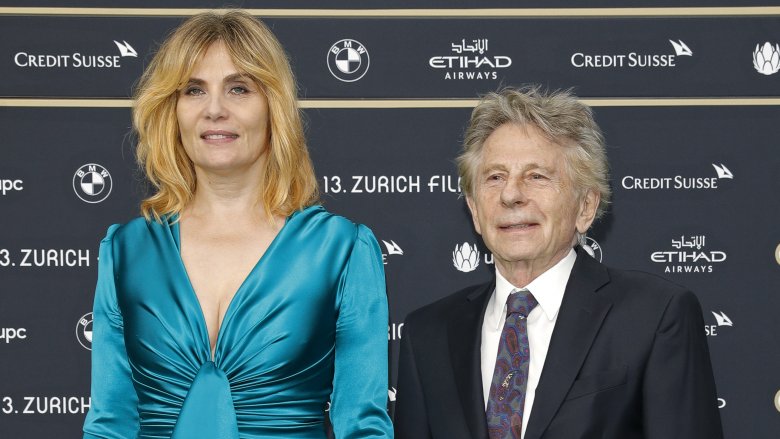The Untold Truth Of Once Upon A Time In Hollywood
In the celluloid circus we call Hollywood, tentpoles reign supreme. As Steven Spielberg observed, "A studio would rather invest $250 million in one" sure bet "than make a whole bunch of really interesting, deeply personal — and even maybe historical — projects that may get lost in the shuffle." But in a sea of formulaic mega-movies, Quentin Tarantino shines as a beacon of creative risk-taking, making really interesting, deeply personal, and sort of historical movies. One such movie is Once Upon a Time in Hollywood, which premiered at the 2019 Cannes Film Festival, where it "reportedly received a six-minute standing ovation."
A period piece set in 1969, the film follows waning TV star Rick Dalton and his trusty stuntman Cliff Booth. The story incorporates actress Sharon Tate, who was eight months pregnant when she was murdered by Charles Manson's Family. Per Entertainment Weekly, critics proclaimed Once Upon a Time in Hollywood to be "a 'profound' masterwork." One review dubbed it a "barefoot eulogy" to Hollywood, noting Tarantino's trademark emphasis on women's feet. Even without seeing the whole movie, there's much to explore in terms of context, subtext, weird coincidences, and controversies. So let's put our bare feet to good use and step into the world of Once Upon a Time in Hollywood.
'Once Upon a Time in Hollywood' is a celluloid love letter
Quentin Tarantino has said "all [his] movies are achingly personal," and in 2019 he described Once Upon a Time in Hollywood as "probably [his] most personal" film. The year in which it's set, 1969, holds special significance. "This is the year that formed me," he explained to Esquire. "I was 6 years old then. This is my world. And this is my love letter to L.A." He originally tried to write that letter as a novel and spent five years working on it.
Why reference the horrific murder of a pregnant actress in a love letter about childhood? We don't know, but according to Tarantino's mother, as a kid he wrote her "sad Mother's Day stories" in which he killed her. Interestingly, his love for his mother and his affinity for onscreen violence might be related. Tarantino told the Telegraph, "My mom took me to the movies all the time" because "it was cheaper than getting a babysitter." He watched violent, R-rated films like Deliverance, which co-starred Burt Reynolds, who was cast in Once Upon a Time in Hollywood before he died. Vintage News noted that the movie's title is also biographically relevant. It alludes to Once Upon a Time in the West and Once Upon a Time in America, films directed by Sergio Leone, who had a huge impact on Tarantino.
The Bandit's last ride ended prematurely
Burt Reynolds was slated to play rancher George Spahn, who ill-fatedly rented his land to Charles Manson. That casting decision seems significant on several levels. Reynolds landed his breakout role in 1972's Deliverance, which Quentin Tarantino watched as a child. Deliverance was emblematic of New Hollywood, an edgier era of filmmaking that started in the late 1960s. Per the British Film Institute, New Hollywood explored more mature themes and featured scenes of extreme violence. These trends reflected "the hip young America of the counterculture" which rejected "the inflated Hollywood blockbusters of the time."
Per the Associated Press, the Manson Family murders partly "exposed the dangerous, drugged-out underside of the counterculture movement" and seemingly signaled "the death of the era of peace and love." Ironically and perhaps intentionally, Burt Reynolds was cast as someone whose real-life counterpart was unwittingly involved in killing the counterculture that spawned New Hollywood. Interestingly, film protagonists Rick Dalton and Cliff Booth are modeled after iconic actor-stuntman pairings like that of Burt Reynolds and Hal Needham. Holdovers from Hollywood's Golden Age, Rick and Cliff face the specter of career death because of the counterculture movement.
Reynolds died of a heart attack before he could shoot his scenes. The role was recast with Reynold's longtime friend and sometimes castmate Bruce Dern. Coincidentally, Dern played the neighbor of a homicidal family in 1989's The Burbs, a film characterized by its screenwriter as "Ozzie and Harriet Meet Charles Manson."
Tarantino worked with a real-life Rick and Cliff
Leonardo DiCaprio and Brad Pitt portray the tight-knit duo of Western TV actor Rick Dalton and stunt double Cliff Booth. As DiCaprio explained to Esquire, "Rick and Cliff, they're part of the old guard in Hollywood, but they're also trying to navigate this new world of the hippie revolution and free love." As Rick tries to halt the sunset of his career, he finds himself living next to Sharon Tate, whose star power is approaching its zenith, and her husband Roman Polanski, "the hottest director in town" at the time.
According to Tarantino, "Sharon and Roman represent the new Hollywood, and Rick is notably not part of it. He doesn't understand it." Rick and his trusty stuntman don't just represent an abstract struggle against looming obsolescence. Their story his rooted in real people Tarantino worked with.
The writer-director said the real-life Rick (whose name he withheld) "had been in the business for a while" and "had a stunt double who he had worked with for 20 years." The stuntman worked for the actor, not Tarantino, who found the duo's dynamic fascinating. "We didn't have anything for the stunt double to do," he recalled, "but there was one little bit" and the actor wanted his stuntman to be used in it. Tarantino "wanted to explore a couple like that toward the end of their careers."
Enter the dragnet
The movie's one-two punch of Rick and Cliff is joined by the one-inch punch of Bruce Lee, portrayed by Mike Moh. The martial arts legend had a crazy connection to the Manson Family murders which author Matthew Polly unpacked in Bruce Lee: A Life. Specifically, Roman Polanski thought Lee committed the murders.
First: a bit of context. Bruce Lee flying-kicked his way into Hollywood with help from hairstylist Jay Sebring, "a gatekeeper for Hollywood's Cult of Cool" who dated Sharon Tate before she married Polanski. Sebring was murdered alongside the pregnant actress and three other people at her home. Lee also knew Tate and Polanski personally. He "taught Sharon Tate how to kick for The Wrecking Crew," gave private lessons to Polanski, and visited their home.
After losing his wife and unborn child a grief-stricken Polanski conducted his own murder investigation. Believing the killers belonged to his inner circle, he zeroed in on Lee because of an awkward coincidence. A pair of glasses had been left at the crime scene — possibly by the killer(s) — and during a training session with Polanski that took place sometime after the murders, Lee had remarked in passing, "I've lost my glasses." Internally panicking, Polanski accompanied Lee to an eyeglasses store and secretly compared Lee's prescription to that of the crime scene eyewear. They didn't match.
Death casts a shadow on and off screen in 'Once Upon a Time in Hollywood'
In both obvious and not-so-obvious ways, Once Upon a Time in Hollywood is defined by actor mortality. Obviously, Sharon Tate and Bruce Lee died shocking deaths in their respective primes. The movie also features fictitious TV actor Scott Lancer, played by Luke Perry in what would be his final role before he unexpectedly passed away from a massive stroke in 2019. Perry's character seems like a clear nod to actor Wayne Maunder, who starred as a different Scott Lancer in the Western TV series Lancer. Maunder, who also appeared with the late Kill Bill actor David Carradine in Kung Fu, died of cardiovascular failure in 2018.
Burt Reynolds was supposed to appear in Tarantino's epic and ran lines with his assistant just before he suffered a fatal heart attack. Even co-stars Brad Pitt and Leonardo DiCaprio have eerie associations with actor deaths. Pitt recalled in an interview that he knew Bruce Lee's son, Brandon, who once confided in Pitt that "he thought he was going to die young like his dad." The following year Brandon was cast in The Crow and fatally shot by an "improperly loaded" prop gun. As a young actor DiCaprio dreamed of meeting River Phoenix. He nearly lived that dream at a party, but Phoenix "vanished" into the crowd before DiCaprio could shake his hand. That same night, Phoenix died of a drug overdose.
The almost-silent film star of 'Once Upon a Time in Hollywood'
A trifecta of talent, charm, and stunning beauty, Sharon Tate had Hollywood written all over her. In fact, her onscreen counterpart, portrayed by Margot Robbie, literally has the word "Hollywood" all over her outfit in Once Upon a TIme in Hollywood. Since the story takes place in Hollywood during a year that defined Quentin Tarantino's life and was defined by Sharon Tate's death, one might surmise that Sharon is a main character. Perhaps that's why culture writer Farah Nayeri pressed Tarantino about how seldom Margot Robbie spoke in the film.
Per CBS, Nayeri raised the issue at a Cannes Film Festival news conference. After noting Robbie's history of impressive performances, she asserted, "Yet you haven't really given her many lines in the movie. I guess that was a deliberate choice on your part. I just wanted to know why that was." A noticeably vexed Taratino limited his own lines in his reply: "I disagree with your hypothesis." Numerous Twitter users disagreed with Tarantino, accusing him of showing disdain toward women both on and off screen.
Robbie had a different take, describing her character's significance as "the loss of innocence," which could be "adequately" conveyed "without speaking." Later, Tarantino told IndieWire that the film is "Rick's story," whereas Sharon is "an angelic ghost on Earth. To some degree, she's not in the movie, she's in our hearts."
'Once Upon a Time in Hollywood' has so many scenes, so little time
The creative process is often an exercise in compromise. No matter the medium, an artist will always be constrained by financial, social, legal, or logistical issues of some kind. One kind of limitation in filmmaking is time — not just how long it takes to make the film, but the duration of the film itself. Thirty-hour movies wouldn't sit well with theaters or the people sitting in them, so scenes and sometimes entire characters have to go. The first version of Once Upon a Time in Hollywood clocked in at nearly four and a half hours, per IndieWire. That was reduced to two hours and 39 minutes for the Cannes Film Festival screening.
Obviously, a lot of scenes ended up on the chopping block, which is a shame because the movie is a smorgasbord of talent. Margot Robbie, Al Pacino, Kurt Russell, Luke Perry, and many other big names that we've cut from this sentence have limited lines and screen time. "Many listed cast don't appear in the movie at all," according to IndieWire. Luckily, Tarantino has carte blanche and has indicated that he may eventually recut the film to make it longer. So all those lucky Cannes attendees might not have seen the version that the general public gets to view.
Is 'Once Upon a Time in Hollywood' in the Tarantinoverse or the other way around?
In 2016 Tarantino revealed to an Australian TV program how his films all relate to each other: "There's the realer than real universe, all right, and all the characters inhabit that one. But then there's this movie universe. ... So basically when the characters of Reservoir Dogs or Pulp Fiction, when they go to the movies, Kill Bill is what they go to see. From Dusk Till Dawn is what they see." But what about Once Upon a Time in Hollywood — a movie that revolves around filmmaking and which Tarantino said is about "the year that formed [him]"? Is it another watchable film in the Tarantinoverse, or does it depict where the other movies are made?
Tarantino famously rewrote history in Django Unchained and Inglourious Basterds and has publicly said he wanted to create a "rewritten history" trilogy. Forbes writer Dan Di Placido posited that Once Upon a Time in Hollywood might complete that trilogy. But maybe Rick Dalton and Cliff Booth are secretly an actor-stuntman tandem in those films. Leonardo DiCaprio (Rick) appears in Django, Brad Pitt (Cliff) is a Basterd. Moreover, their respective characters appear in scenes wearing suits with boutonnières, creating a clear visual link. Inglourious Basterds also features Hitler and other prominent Nazis being "incinerated in a Paris cinema" while the trailer for Once Upon a Time in Hollywood shows DiCaprio setting Nazis on fire.
'Once Upon a Time in Hollywood' has a connection to Bruce Lee
If you watched the March 2019 teaser trailer for Once Upon a Time in Hollywood that featured Bruce Lee engaging in fisticuffs with stuntman Cliff Booth, you may have raised an incredulous eyebrow when Booth didn't immediately enter the dragon's mouth and get eaten alive — metaphorically, of course. Instead, Booth seemed to hold his own, at least briefly. The Wrap noted that this pissed off numerous viewers. Some found it implausible "that Brad Pitt would stand a chance" while others slammed the sequence as a "white male power fantasy" or felt Lee was disrespected on screen.
The Wrap asked Bruce Lee biographer Matthew Polly to weigh in, and perhaps unsurprisingly, he wasn't bothered by this snippet of a fictional fight between not-really-Bruce Lee and not-actually-Brad-Pitt-in-this-storyline. To be clear, we don't just mean that an actor played Lee. According to Polly, "It's a pretty good representation of the fighting style of Lee's character Kato on The Green Hornet. Lee himself didn't fight like Kato in real life — he invented a new style for the series. Tarantino is riffing on the Kato character."
Is 'Once Upon a Time in Hollywood' Tarantino's 'Summer of Sam'?
The interpretation of art is subjective, and even when it isn't, people see what they want to see anyway. Here, it's easy to see how people would think the movie is fundamentally about the Manson Family murders. In the trailers and preliminary descriptions, all roads seem to lead to Charles Manson, played by Damon Herriman. Brad Pitt's character appears to travel on a literal road to the cult leader's compound. He also trades blows with Bruce Lee, who was indirectly connected to the slayings. Leonardo DiCaprio's character is Sharon Tate's neighbor. Yet according to Tarantino, "It's not Charles Manson; it's 1969."
Producers David Heyman and Shannon McIntosh elaborated on that point, saying, "It's about the loss of innocence that came about in 1969 with the Manson Family" and about the bond between characters Rick and Cliff. But since people see what they want to see, we'll observe parallels with a film by Tarantino's longtime antagonist Spike Lee.
In July 1999, almost exactly 20 years before the scheduled July release of Once Upon a Time in Hollywood, Spike Lee's Summer of Sam hit theaters. Though seemingly about killer David Berkowitz, the movie was really "about that summer, 1977," according to Lee. It was the carefree prelude to the age of AIDS. It was also the summer when Lee discovered he wanted to be a filmmaker, somewhat echoing the formative influence of 1969 on Tarantino.
Debra Tate's change of heart about 'Once Upon a Time in Hollywood'
Even if you consider Tarantino a virtuoso writer-director, you might have noticed that tact isn't his biggest virtue. He has a history of bristly interviews, using the N-word almost gratuitously in movies, and depicting violence in the most graphic fashion imaginable. Whether or not you find the latter two patterns artistically meaningful, it makes sense that the prospect of a Tarantino film that refers to the murder of Sharon Tate would make the late actress' sister, Debra, wary about how the director would handle it. It probably didn't allay Debra's concerns that the film's initial release date was "the 50th anniversary of the Manson Family murders," per the Independent.
Debra tore into Tarantino's flick, reportedly telling TMZ, "To (celebrities) it's a paycheck and these people just don't care. They are terribly hurtful to the actual family and all the living victims. They don't give a sh*t." But then the director contacted her, the release date was changed, and Debra accordingly had a change of heart. Speaking with People, she said, "[Tarantino] has done nothing but respect me and be very forthcoming. I have very high hopes for this project."
'Once Upon a Time in Hollywood' casts an outcast
Long before the MeToo movement called for a reckoning in Hollywood, Roman Polanski, played by Rafal Zawierucha in Once Upon a Time in Hollywood, proved that making great art doesn't make you a great person. The once-celebrated director cemented his filmmaking legacy with 1968's Rosemary's Baby but fled to France in 1977 after admitting to drugging and raping 13-year-old Samantha Geimer. In the decades that followed more women came forward to accuse Polanski of similar offenses, prompting the Academy of Motion Picture Arts and Sciences to oust him.
Quentin Tarantino has described himself as "a fan of Roman Polanski's work," especially Rosemary's Baby. He's met the director in person and even defended Polanski's abhorrent behavior in a 2003 Howard Stern interview, calling it "not rape" and claiming Geimer "was down with" her assault. In 2018 Tarantino — who had recently been embroiled in a MeToo controversy after admitting he knew about sexual harassment and assault allegations against his mentor, Harvey Weinstein — publicly apologized to Geimer after his comments resurfaced. The following year Tarantino came under fire from Polanski's wife, French actress Emmanuelle Seigner (above). Seigner complained that Tarantino was profiting from "Roman and his tragic story" without so much as consulting him, all while Hollywood "continues to reject" the director. Then again, Polanski escaped justice, married a woman approximately 33 years his junior, and continued directing movies abroad. So maybe life just isn't fair.
